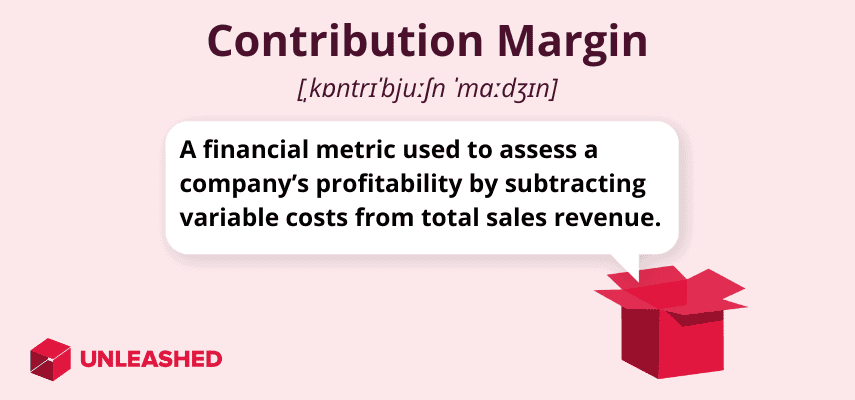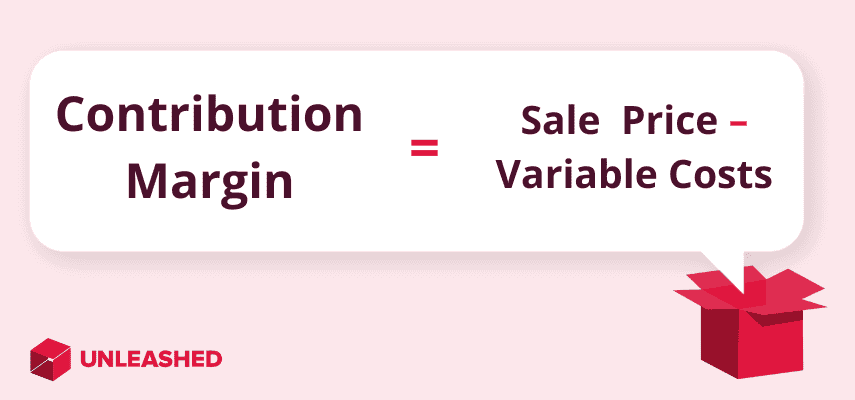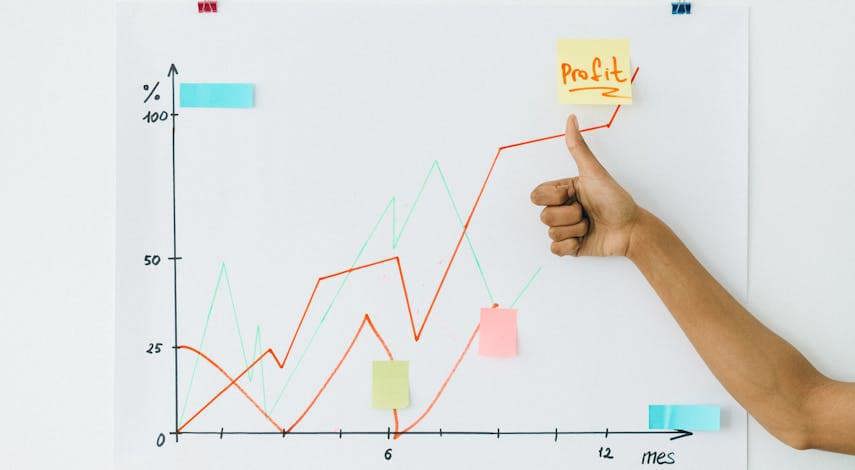
Your contribution margin shows you how much revenue is left after you’ve covered your variable costs, and how much is available to cover your fixed costs, such as rent, utilities, and payroll.
The contribution margin formula is essential for making the right decisions for your business – especially when creating budgets, accounting for inventory, and pricing products.
Here we explore how the contribution margin is used in modern business, how to calculate it using the contribution margin formula, and a few best-practice strategies for improving your contribution margin.
What is the contribution margin?
The contribution margin ratio is a financial metric used to assess a company’s profitability. It represents the portion of your sales revenue not used by variable costs and therefore contributes to covering your fixed costs.
The contribution margin is calculated by subtracting the variable cost per unit from the selling price per unit.
This ratio is crucial for determining the break-even point of sales and making informed decisions about pricing, cost control, and sales strategies. It is particularly useful when evaluating the impact of changes in sales volume, product prices, or variable costs on a company's profits.
The contribution margin is expressed as either a ratio or a percentage of the selling price, which indicates the portion of each dollar of sales that helps to cover your fixed costs and generate profit.

Contribution margin vs gross margin
Contribution margin and gross margin are both important profitability metrics, but they differ in what they reflect about your business's financial health.
The contribution margin provides insight into the profitability of individual items or services before fixed costs are considered. Gross margin, on the other hand, provides a view of your overall profitability after accounting for the direct costs associated with producing your goods sold.
- Related: What is a Good Profit Margin?
Why and when to use the contribution margin ratio
The contribution margin offers visibility into the profitability of individual products. It does so by measuring how sales affect net income.
Because it is calculated by subtracting variable costs from sales revenue, it surfaces the incremental profit earned for each unit sold and indicates how much revenue contributes to your fixed costs and profits.
You should use the contribution margin ratio when assessing product lines, pricing strategies, and overall business profitability to make informed decisions about where to focus resources for maximum financial gain.
By understanding when and why to use this ratio, you can better navigate financial planning and performance evaluation.
Calculating the contribution margin
The contribution margin is calculated by subtracting the variable costs of producing and selling your product or service from its revenue.
It can be expressed as a percentage of revenue, which indicates the percentage of each sales dollar left after covering the variable costs. It can also be used to calculate your break-even point, which is the level of sales that covers all your fixed and variable costs.
These costs may be recorded and tallied manually. For a faster, more accurate way of recording your costs, you may wish to invest in automated inventory management software instead.
To make calculating the contribution margin easy, use the contribution margin formula below.
Contribution margin formula
The contribution margin formula helps you determine the profitability of individual items or services that your business sells. It is calculated by subtracting the variable costs of producing each item from its sale price.
The contribution margin formula is:
Sale Price - Variable Costs = Contribution Margin
The variable cost per unit combines all your expenses that change with the number of units produced or sold, such as materials, labour, and commissions.
This metric is crucial for setting product prices, determining break-even points, and making strategic business decisions.

Contribution margin per unit vs total contribution margin
In cost accounting, the contribution margin per unit is a valuable metric that represents the incremental money generated for each unit sold and contributes to covering your company's fixed costs.
It is a useful performance indicator for conducting a cost-volume-profit analysis.
Conversely, your total contribution margin represents the total earnings available to cover fixed costs and generate a profit. To calculate your total contribution margin, subtract all variable expenses from your total sales revenue (or your total available earnings) to cover fixed expenses and generate profit.
This is calculated as total sales minus total variable costs.
Contribution profit margin
The contribution profit margin represents the portion of sales revenue not consumed by variable costs and so contributes to covering the fixed costs of your business.
As a financial metric, the contribution profit margin measures your profit after you’ve deducted variable costs. It assesses the profitability and efficiency of your company's core business activities, excluding any fixed costs.
The formula to calculate the contribution profit margin is:
(Sales Revenue - Variable Costs) / Sales Revenue = Contribution Profit Margin
For example, if you sell a product for $100 and the variable cost per unit is $60, the contribution profit margin is $40. This can be calculated as:
($100 - $60) / $100 = 0.4 or 40%
This margin helps you assess the profitability and efficiency of your core business. It indicates the amount each product contributes to company profits and helps you to make smart strategic decisions around your pricing, cost control, and product mix.
How to improve contribution margin
To improve your contribution margin, you must incorporate profit-driving activities into your business strategy.
5 effective tactics for increasing your contribution profit margin:
- Optimising pricing strategies
- Reducing direct costs
- Enhancing product mix
- Improving your operational efficiency
- Marketing and sales strategies
Let’s break these down.
1. Optimise product pricing
Consider implementing optimal pricing strategies to improve your contribution margin. This involves analysing factors such as market demand, competitor pricing, and cost of goods sold to determine the best price point that maximises profit without sacrificing sales volume.
Some techniques for optimising product pricing:
- Analyse the price elasticity of your products – Adjust pricing to maximise their total contribution margin.
- Increase your prices – If market conditions allow, raising prices can directly widen margins.
- Implement tiered pricing – Create multiple pricing levels to cater to different customer segments.
Contribution margins represent the difference between the selling price and the cost of goods sold and are crucial for enhancing overall profitability. By optimising your pricing strategies, you can significantly improve your contribution margin.
2. Reduce your costs
It’s also possible to improve your contribution margin by analysing your cost structure and identifying areas where expenses can be minimised without sacrificing quality.
This could involve negotiating better terms with suppliers or finding more cost-effective production methods. Look for opportunities to reduce direct costs without compromising quality.
A few tips for reducing business costs:
- Cut your variable costs – Negotiate with your suppliers for better rates or find cost-effective alternatives. A restaurant could switch to a supplier that offers less expensive dry ingredients.
- Implement lean manufacturing techniques – Eliminating waste and investing in technology to automate processes can save you time and money while improving your total contribution margin.
- Regularly review and adjust your operations based on resource consumption data – By meticulously analysing every aspect of your expenses you can find ways to cut costs and improve your bottom line significantly.
- Optimise resource usage – Once you have the data to work from, boost resource usage through careful inventory management and simplified production processes.
As a final tip, look for ways to reduce costs by sourcing cost-effective materials that won’t compromise your product’s quality. Focusing on high-margin products, upselling, and cross-selling can help in improving the overall contribution margin.

3. Optimise your product mix
By optimising the selection and proportion of products you offer, you can maximise revenue while minimising costs, leading to a healthier bottom line.
Assess which products or services have the highest contribution margins and focus on selling more of these items.
To improve your product mix, focus on selling higher-margin items. A computer store might promote high-end laptops over budget models with lower margins.
You may also benefit from reducing your total number of discounts, product bundles, and promotions. Limiting the number of discounts preserves your product's contribution margin and its value perception.
To enhance your contribution margin, it's essential to analyse and adjust your product mix strategically. This means evaluating the profitability of each product and focusing on those that offer the best return on investment.
4. Increase your operational efficiency
One way to improve your contribution margin is to focus on boosting operational efficiency.
Streamlining your operations to reduce waste and improve productivity will help to reduce your variable costs. This can be achieved by automating key processes, optimising resource allocation, and eliminating waste.
Invest in the right tools and technology to automate your workflows, such as manufacturing software or barcode scanners. This can improve operational efficiency and reduce waste and labour costs.
Your operational processes can also benefit from scrutiny. For example, a manufacturer could reorganise the production line to minimise the occurrence of downtime.
Look for ways to improve your energy efficiency and eliminate downtime. Implement efficient production processes, use sustainable materials, and employ energy-saving technologies.
These will all help you lower costs without compromising on quality or output, leading to a healthier contribution margin.
5. Invest in marketing
It's essential to employ targeted marketing strategies to help improve your contribution margins.
By focusing on specific segments of your market that are most likely to convert, you can allocate your resources more efficiently and boost your overall profitability.
Here are some tactics for effective marketing:
- Target marketing activities – Attract higher-paying customers or more sales at full price. A health and supplement brand could invest in a marketing campaign highlighting the quality of its products.
- Upsell and cross-sell – Encourage customers to purchase premium products or additional items. For example, a car dealership might offer extended warranties or vehicle accessories.
- Analyse customer data to identify purchasing patterns – Determine customer preferences that enable you to tailor your marketing efforts, ensuring that they resonate with the intended audience. This focused approach not only increases the likelihood of higher sales but also improves customer satisfaction by providing relevant offers and information.
Contribution margin on income statement
On your company income statement, you start with revenue and subtract the cost of goods sold to get your gross profit. Then you subtract operating expenses to get your operating profit and finally, you deduct taxes, interest, and everything else to reach your net profit.
Do the calculation differently, taking out variable costs, and you’ll find your product's contribution margin. This figure is vital as it contributes to covering the fixed costs of your business and provides your profit once those fixed costs are met. It is calculated by subtracting your total variable expenses from your net sales revenue.
High contribution margin vs low contribution margin
A high contribution margin indicates that a product is generating more profit per unit sold, which can contribute significantly to covering the fixed costs and potentially delivering a strong net profit. A high margin is generally seen as good because it implies that the product can sustain price reductions, increased variable costs, or sales volume fluctuations while still maintaining profitability.
Conversely, a low contribution margin suggests that the product's profitability is lower, making it more challenging to cover fixed costs and achieve profitability. A low contribution margin might signal that the product's pricing strategy needs to be reassessed or costs need to be managed more effectively to improve profitability.
